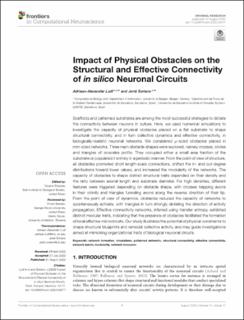| dc.contributor.author | Ludl, Adriaan-Alexander | |
| dc.contributor.author | Soriano, Jordi | |
| dc.date.accessioned | 2021-07-02T08:19:46Z | |
| dc.date.available | 2021-07-02T08:19:46Z | |
| dc.date.created | 2020-09-25T12:17:57Z | |
| dc.date.issued | 2020 | |
| dc.Published | Frontiers in Computational Neuroscience. 2020, 14:77 1-20. | |
| dc.identifier.issn | 1662-5188 | |
| dc.identifier.uri | https://hdl.handle.net/11250/2763041 | |
| dc.description.abstract | Scaffolds and patterned substrates are among the most successful strategies to dictate the connectivity between neurons in culture. Here, we used numerical simulations to investigate the capacity of physical obstacles placed on a flat substrate to shape structural connectivity, and in turn collective dynamics and effective connectivity, in biologically-realistic neuronal networks. We considered μ-sized obstacles placed in mm-sized networks. Three main obstacle shapes were explored, namely crosses, circles and triangles of isosceles profile. They occupied either a small area fraction of the substrate or populated it entirely in a periodic manner. From the point of view of structure, all obstacles promoted short length-scale connections, shifted the in- and out-degree distributions toward lower values, and increased the modularity of the networks. The capacity of obstacles to shape distinct structural traits depended on their density and the ratio between axonal length and substrate diameter. For high densities, different features were triggered depending on obstacle shape, with crosses trapping axons in their vicinity and triangles funneling axons along the reverse direction of their tip. From the point of view of dynamics, obstacles reduced the capacity of networks to spontaneously activate, with triangles in turn strongly dictating the direction of activity propagation. Effective connectivity networks, inferred using transfer entropy, exhibited distinct modular traits, indicating that the presence of obstacles facilitated the formation of local effective microcircuits. Our study illustrates the potential of physical constraints to shape structural blueprints and remodel collective activity, and may guide investigations aimed at mimicking organizational traits of biological neuronal circuits. | en_US |
| dc.language.iso | eng | en_US |
| dc.publisher | Frontiers | en_US |
| dc.rights | Navngivelse 4.0 Internasjonal | * |
| dc.rights.uri | http://creativecommons.org/licenses/by/4.0/deed.no | * |
| dc.title | Impact of physical obstacles on the structural and effective connectivity of in silico neuronal circuits | en_US |
| dc.type | Journal article | en_US |
| dc.type | Peer reviewed | en_US |
| dc.description.version | publishedVersion | en_US |
| dc.rights.holder | Copyright 2020 The Authors | en_US |
| dc.source.articlenumber | 77 | en_US |
| cristin.ispublished | true | |
| cristin.fulltext | original | |
| cristin.qualitycode | 1 | |
| dc.identifier.doi | 10.3389/fncom.2020.00077 | |
| dc.identifier.cristin | 1833415 | |
| dc.source.journal | Frontiers in Computational Neuroscience | en_US |
| dc.source.40 | 14:77 | |
| dc.identifier.citation | Frontiers in Computational Neuroscience. 2020, 14, 77 | en_US |
| dc.source.volume | 14 | en_US |

